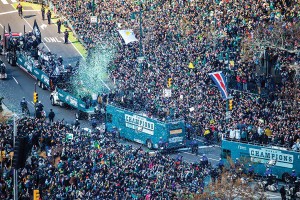Sports: Winter in Conlinland
Being marginalized, ignored and otherwise relegated to has-been — even though he’s still, at 75, this city’s best columnist — has Bill Conlin raging into the night at bloggers foolish enough to disagree with his sporting assessments, and e-mailing anyone who will listen about just how good he was and still is. (You might also get e-mailed a snapshot of a young, much thinner Bill on a surfboard.) So no, he hasn’t recovered from that last World Series he traveled back and forth across the country to write about in ’01; he hasn’t gotten over the way he and the other, lesser writers, were herded to a room with tiny TVs.
Irma pokes her head out from the house, tells him the Mets have lost to the Marlins. Conlin nods, pleased. He’ll keep ranting from home.
A HALF-CENTURY AGO, sportswriters didn’t even talk to ballplayers. They watched games, then told us what happened.
Interviewing players, prodding, poking, understanding them as people, and even using the emerging tools of literary journalism to create scenes to bring them to life as characters and stir up trouble — all that was a new toy just as Conlin was starting out in the mid-’60s. So was the idea of our national pastime as a grand metaphor for the most brutal business of life — and at that, Conlin was, and still is, a master:
“The Phillies and the Dodgers have played four games this spring,” Conlin once began a story, “and late-arriving fans have missed 11 first-inning runs by the Dodgers. That’s like spotting Frank Rizzo 50,000 votes in South Philly, like giving Seattle Slew a three-second start in the Preakness. Look at all the trouble there was when Neville Chamberlain spotted Hitler Austria and Czechoslovakia.”
As for the players themselves, Conlin saw his fair share of boys behaving badly during his career: plenty of late-night booze fests at the hotel bars, plenty of stuff that he’s (begrudgingly) tucked away about them. “I used to sit in front on the team plane and block everything out,” Conlin says. “I never allowed myself to go back there and see what was going on, even though I knew what it was.”
Oh, he did dip into the shallow end every once in a while, but only in unique (and obvious) circumstances. Somebody had to explain Steve Carlton. After Lefty went an otherworldly 27-10 in 1972, his first season with the Phils, he thudded back to earth quite rapidly in 1973, going 13-20. Conlin knew why. Or at least he thought he knew why: “In my opinion, he was too busy fooling around, drinking too much, and out of shape,” he says now. “I didn’t write that, but I definitely hinted at it.” Carlton noticed. Their relationship soured. This was extremely uncomfortable, exacerbated by the fact that Conlin’s wife Irma and Carlton’s wife at the time, Beverly, were friends. The Carlton kids and the Conlin kids spent a lot of winters running around together in Clearwater, where the Phillies train. Super-private Lefty felt Conlin had violated their friendship. “A writer should never permit that [type of relationship] to happen,” Conlin says. But in that era, every sportswriter had to decide how to draw that line.


